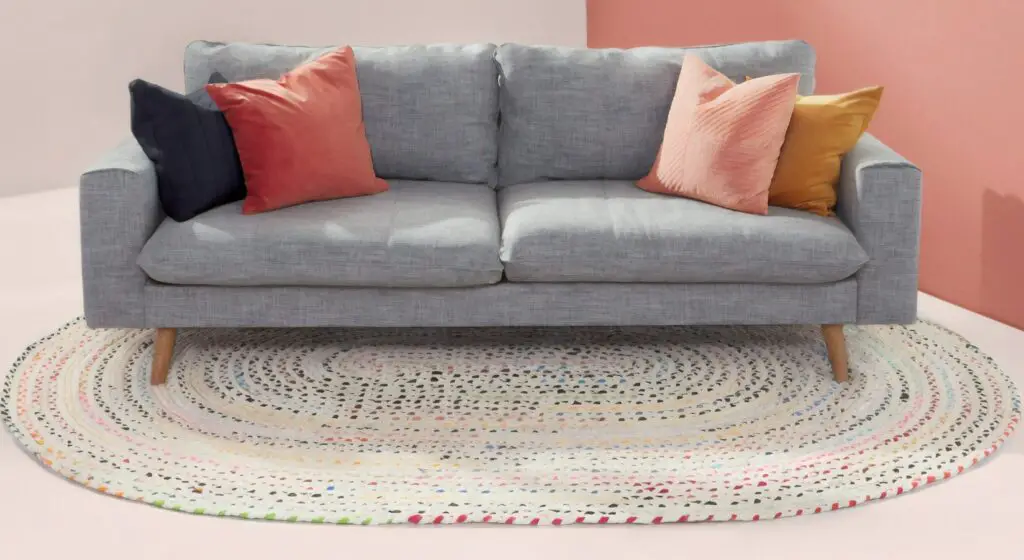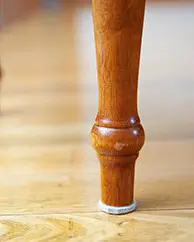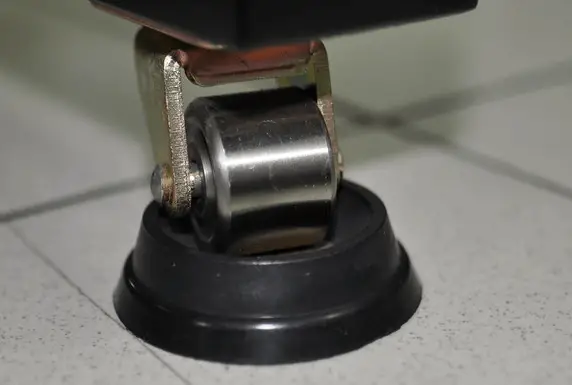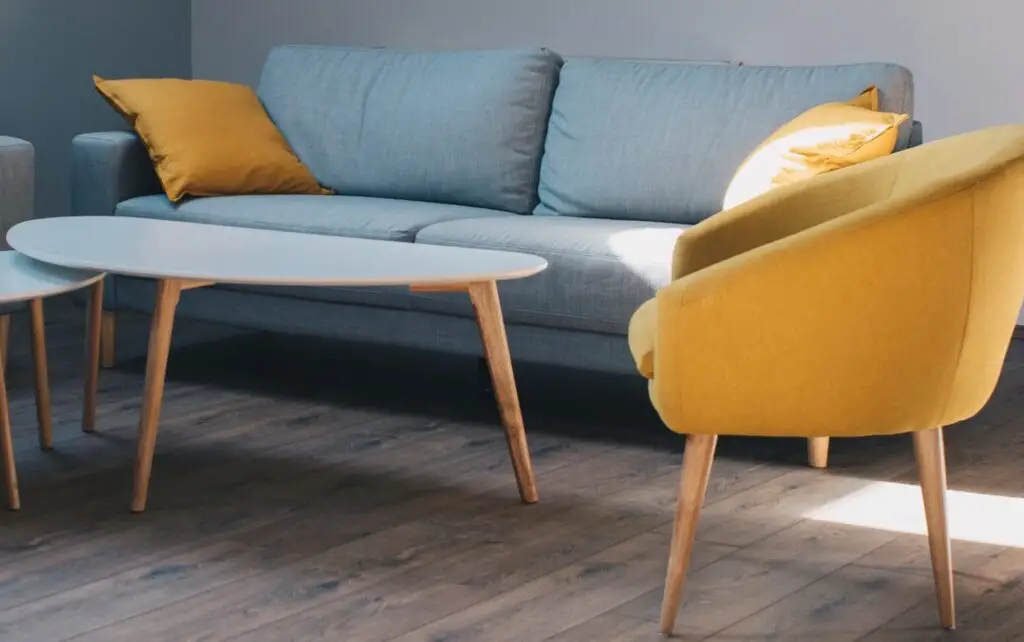If you have a hardwood floor without a rug, chances are that you have felt your couch, recliner, or chair sliding every time you seat on it.
While repositioning may not seem like much work, the sliding furniture can easily scratch and damage the wood floor.
This is why in this article we decided to explain various ways how to keep furniture from sliding on the wood floor.
But before you find that solution, you need to know why your seats keep moving around on the floor.
5 Hacks on how to keep furniture from sliding on wood floor
Your furniture might not stay in place due to wheels, wooden legs, or hardwood floor, but you can still prevent it from happening. You can keep furniture from sliding on the wooden floor by placing an area rug and using furniture grippers for hardwood floors. You can also use items like stop blocks, furniture caster cups for hardwood floors, or self-adhesive cork squares and see what works best for you.
Let’s discuss this in detail:-
1. Place an area rug
If your furniture is not spread across the room, then an area rug may be the way to go.

Area rugs like this Safavieh California Premium Shag cover a small portion of the room under the furniture such as couches, sofas, and tables in order to prevent them from sliding on the floor.
They also help to provide a comfortable area to walk on, especially for kids rather than stepping on the cold floor.
The size of the area rug you choose will depend on how much of the floor you want to cover under the furniture. It will also depend on the overall décor of the room.
You want to get a rug that will blend well with the theme of your room.
However, some rugs do not have a firm grip on the floor so you may need to get a non-slip pad and place it under the rug so that it stays in place.
See also: Best entry mats for hardwood floors
2. Furniture grippers for hardwood floors
Furniture grippers are also referred to as rubber pads, felt pads, or furniture pads.
No matter the name, furniture grippers are easy to use and play a major role in keeping the furniture in place.
The grippers such as the X-Protector Non-slip furniture pads have an anti-slip backing that secures the furniture firmly on the floor to prevent slipping. Hence, they protect both the floor and the legs of the furniture.

The grippers/pads come in a pack and in different sizes. So before you buy them, take the measurement of your furniture legs in order to choose the right size.
To fix, simply place them under the legs of the furniture as shown in the image.
3. Stop Blocks
Stop blocks come in handy if your couch or sofa keeps moving backward and bumping onto the wall.
The blocks are also referred to as spacers and are usually made of wood.
To stop the furniture from sliding, attach the wood blocks onto the rear end of the furniture legs.
The blocks should be long enough to touch the baseboard so as to prevent the seat from sliding backward.
If you are a DIY person, you can simply make the stop blocks by cutting wood into strips rather than buying.
See also: Best battery pack for reclining furniture
4. Furniture caster cups for hardwood floors
Furniture caster cups are placed on the legs of the furniture to reduce friction against the floor. This protects the floor from marks and scratches.
They can be used to protect all types of floors from hardwood to laminate, vinyl, and tiled floor.
With the caster cups on, the furniture is also easy to slide on the floor during cleaning without the annoying sound.
The most commonly used are the CalPalmy rubber caster cups that have an anti-sliding floor grip. They are made from premium dense rubber so they can handle even the weight of heavy furniture like beds and couches.
Furniture caster cups can also be used on wheeled furniture to prevent unnecessary movement as shown below.

5. Self-adhesive cork squares
The self-adhesive cork squares are well textured, sturdy, and non-slip.
This makes them ideal for stopping the furniture from sliding and scratching the floor.
You can purchase the corks such as the Before you self-adhesive cork squares from any store.
To use them, just peel off the adhesive and stick the squares under the legs of the furniture.
If you feel the squares are too thin, you can stick multiple corks together to increase their thickness and ensure maximum floor protection.
See also: Best sofa cushion support
Why does furniture slide on the wood floor?
There is no doubt that there is a problem that makes your furniture not stay in one place.
We can pinpoint a few but most likely your furniture lacks a good grip on the floor.
This could be due to the fact that the furniture has wheels, the legs are wooden, or the hardwood floor has an extremely smooth finish or it is dusty.

Whatever the reason, the furniture won’t stay in place unless you come up with a solution.
So let’s look at some of what to put under furniture on hardwood floors to keep them from sliding.
Non-slip solutions for furniture by type
When it comes to preventing the furniture pieces from sliding off the floor, the most common solution is buying furniture grips. To be fair, they do the job just well, but they aren’t a sustainable option.
Most of the furniture grips available in the market often contribute to scratches and damage to the floor. Moreover, they also reduce the quality and stability of the furniture in the long run.
Regarding non-slip solutions for your furniture, you need to keep certain factors in mind. From the type of furniture piece you are dealing with to the kind of flooring you have, you need to pay close attention to a lot of things.
While sorting out the best non-slip solutions for furniture, we wanted to curate a list by type, so it’s easier to navigate through.
1. Keep Chair from Sliding on Wood Floor
If you have a hardwood floor without any excess carpeting on top, the chances are that the risk of sliding the chairs is quite high. A lack of gripper on the bottom will eventually contribute to accidents that you could easily prevent with simple solutions.
Wondering what the simple solution is?
Rugs with rug pads.
These are some of the most cost-efficient non-slip solutions for chairs and other flimsy pieces of furniture. Also, they are a long-term solution, provided that you buy a good-quality option.
Most people simply throw a rug underneath the chair to increase the friction. This will work in the short term, especially on the wooden floor. If the rug doesn’t have rug pads underneath, the rug is more likely going to skid and cause an accident.
Even the quality of the rug pad makes a lot of difference. Your aim is to find a high-quality rug pad that is made of natural rubber. Avoid the ones made of polyvinyl carbonate (PVC) since they don’t work as efficiently.
The natural rug pads, on the other hand, are long-lasting, have a more fractioned grip on the floor, and are eco-friendly. But, what sets them apart is the compatibility. Even when you throw it on a wooden floor, the rug pad doesn’t cause any damage to the floor’s appearance.
2. Stop Couch From Sliding
Moving ahead from the chairs, the next thing to focus on is the couch in your living room. Especially if you have a couch with feet, the chances are that it will slip and skid across the wooden floor.
The easiest way to minimize that risk is by using silicone chair leg caps. They are similar to the furniture gripper but a lot better in terms of quality and functionality.
There are a few different variants available, including the staple peel and stick pads, the cup pads, and the screw-on pads. Which one you decide to pick up and add depends on the couch’s quality and material.
The peel and stick pads are one of the most affordable, but we’d include more towards the latter two. If you are someone who has a habit of moving their couch around in the living room, you will benefit from using the screw-on or cup pads. They are also a lot more resilient in comparison.
Also, these come in different shapes, sizes, and designs that will match up to the design of your couch’s feet.
3. Prevent Bed from Sliding
Have you ever sat down on a recliner or bed and witnessed it sliding from its position? It might be difficult for a bed to move substantially, but it happens, especially with minimal friction against the flooring.
The stop blocks come in handy in such cases. They are multipurpose and proactively prevent furniture pieces from sliding from their designated position.
However, finding easily accessible stop blocks in the market is difficult. Since they are generally blocks of wood or similar furniture piece, you’d need to sit back and DIY the whole thing.
But, the good part about using stop blocks is that they are a permanent solution. Once you place them between the bed’s leg and the wall, you can rest easy, knowing that your furniture won’t slide off the side anymore.
4. Focus on Cleaning
Do you know one of the most underrated reasons why furniture slip on the floor? It is due to a dirty floor. If you have sticky, oily, or even watery residue on the floor, chances are that the same will contribute to poor reduced friction between the furniture and the floor.
What does this do? It makes your furniture slide off the floor and keeps them unstable on the floor.
It is tiresome work because you have to clean the floor whenever you spill something proactively. But it reaps amazing results in the long run, which is quite promising.
How to keep furniture from sliding and scratching hardwood floors
In the above section, we have talked about things you can put under furniture to keep chairs, sofas, recliners, and even beds in place. These will help to keep furniture from sliding and damaging the floor with scratches.
However, apart from purchasing the above-mentioned items, you need to ensure the floor is always clean and free of dust.
Some furniture protectors won’t stay in place if the floor is dusty. Felt floor pads for instance may pick up a lot of fluff and grit thereby making it easy for them to slide on the floor. Thus, you need to clean the floor regularly.
Moreover, you need to check the legs of the furniture regularly to see if they are worn out. If the furniture has wheels and they come off, there is no doubt the remaining part will scratch the hardwood floor.
Thus, regular checking and maintenance of furniture are very important.
See also: Best chair mats for carpet
FAQ
There are a few different ways to keep your furniture in place on hardwood floors. You can use furniture grippers, lay-out rugs, carpet pads, felt pads, or wooden blocks to stabilize them on the floor.
Since couches are a larger furniture piece that is in the middle of your living room, you want to add something inconspicuous but safe at the same time. Rugs with rug pads and even rubber pads for the individual leg of the couch work wonders in keeping the furniture in place.
If you don’t want to go to the store and buy furniture grippers, some of the DIY methods include adding wooden blocks as a stopper from sliding. Besides that, you can also use rug pads or sticky furniture pads to keep them in place.
Besides putting a thick carpet or rug, we recommend adding a thicker pad underneath to hold everything in place. Putting the furniture on the rug without any grip on the bottom will make things slide on the hardwood floors.
Conclusion
If your sliding furniture has been a bother, we have given some ideas on how to keep furniture from sliding on the wood floor.
You can try placing an area rug, using furniture grippers, felt or rubber pads, furniture caster cups, stop blocks, and self-adhesive cork squares. You don’t have to try all these methods; just pick the one that you feel will be more suitable for your furniture and floor.